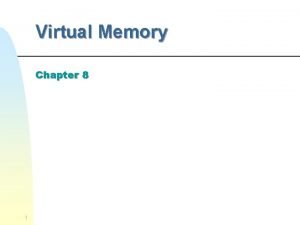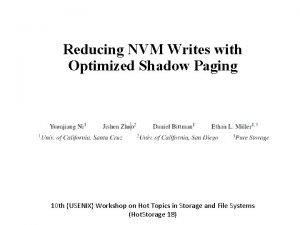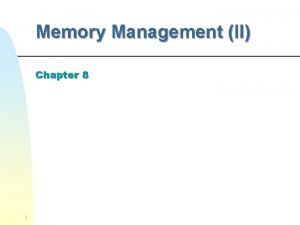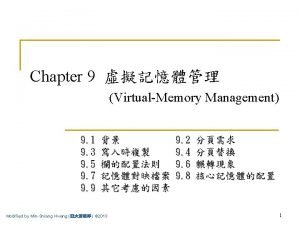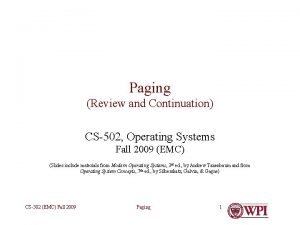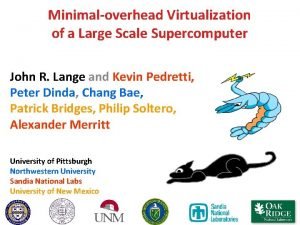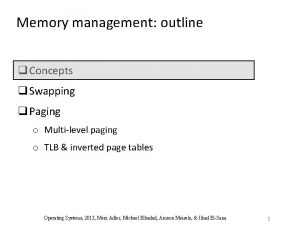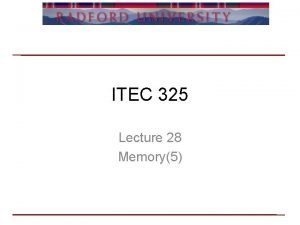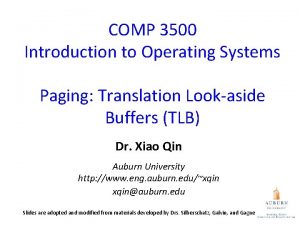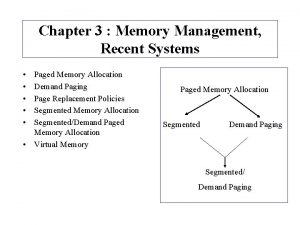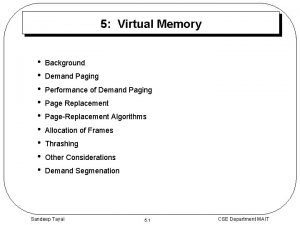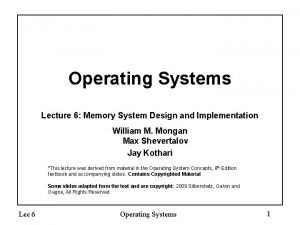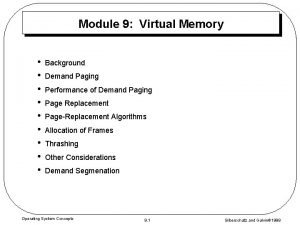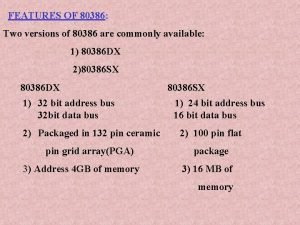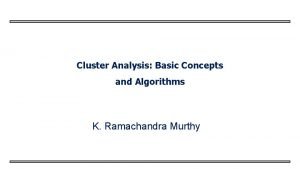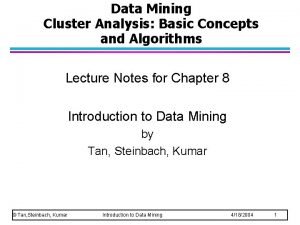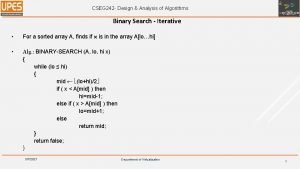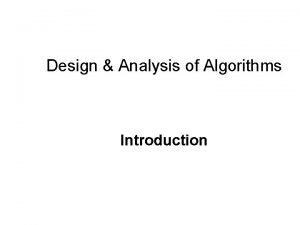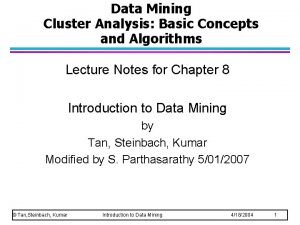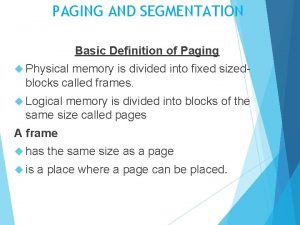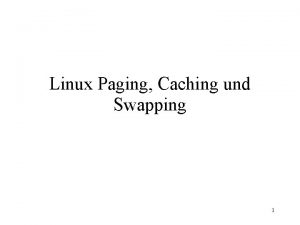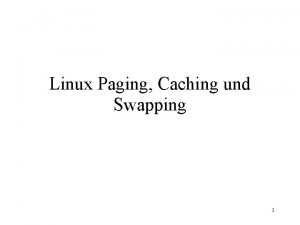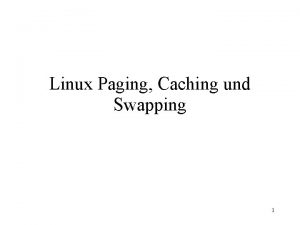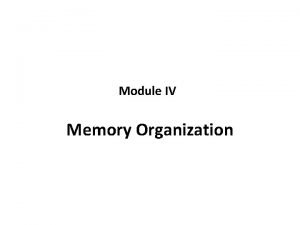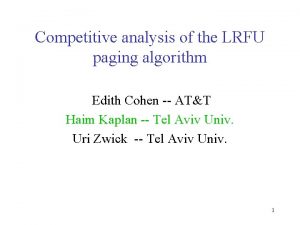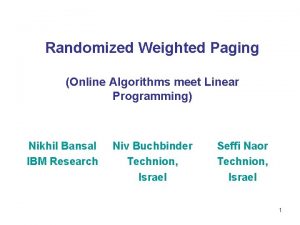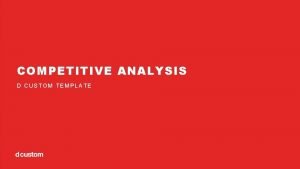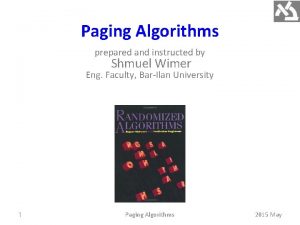Online Algorithms and Competitive Analysis Paging Algorithms Data


















![Previous work • Concave Analysis. Albers, Favrholdt, Gielet [STOC ‘ 02] LRU ≠ certain Previous work • Concave Analysis. Albers, Favrholdt, Gielet [STOC ‘ 02] LRU ≠ certain](https://slidetodoc.com/presentation_image/047011f4559e24f121147eafdfd28565/image-19.jpg)
































![Strict separation Σσ A(σ) > Σσ LRU(σ) [sum by rows] Compute the number of Strict separation Σσ A(σ) > Σσ LRU(σ) [sum by rows] Compute the number of](https://slidetodoc.com/presentation_image/047011f4559e24f121147eafdfd28565/image-52.jpg)







- Slides: 59

Online Algorithms and Competitive Analysis

Paging Algorithms • Data brought from slower memory into cache RAM CPU

Paging Algorithms • Data brought from slow memory into small fast memory (cache) of size k • Sequence of requests: equal size pages • Hit: page in cache, • Fault: page not in cache

Minimizing Paging Faults • On a fault evict a page from cache • Paging algorithm ≡ Eviction policy • Goal: minimize the number of page faults

Worst case • In the worst case page, the number of page faults on n requests is n. E. g. cache of size 4, request sequence p 1 p 2 p 3 p 4 p 5 p 6 p 7 p 8 p 9 p 10 p 11 p 12

Difficult sequences Cache of size 4, request sequence p 1 p 2 p 3 p 4 p 5 p 6 p 7 p 8 p 9 p 10 p 11 p 12 Sequence is difficult, for one it never repeats pages so it is impossible to have a page hit

Compare to optimal p 1 p 2 p 3 p 4 p 5 p 6 p 7 p 8 p 9 p 10 p 11 p 12 p 13 … is hard for everyone (i. e. 13 faults) p 1 p 2 p 3 p 4 p 5 p 1 p 2 p 3 p 4 … 8 faults Optimal algorithm knows the future

Offline optimum Optimal algorithm knows the future, i. e. offline OPT. Compare online paging strategy to offline paging strategy

Competitive Ratio Defined as : sup I cost of online algorithm on I cost of offline optimum on I

Paging • One of the earliest problems to be studied under the online model • Competitive ratio defined by Sleator and Tarjan

Competitive Ratio • First appeared in the 1960’s in search context, e. g. – – – – On the linear search problem (Beck, 1964) More on the linear search problem (1965) Yet more on the linear search problem (1970) The return of the linear search problem (1972) Son of the linear search problem (Beck & Beck 1984) The linear search problem rides again (1986) The revenge of the linear search problem (1992) • Shmuel Gal – Search Games, Academic Press, 1980 – Theory of Search Games and Rendezvous (with Steve Alpern), Kluwer Academic Press, 2002

Paging Algorithms • Least-Recently-Used (LRU) • First-In-First-Out (FIFO) • Flush-When-Full (FWF) Classes of Paging algorithms • Lazy Algorithms: LRU and FIFO • Marking Algorithms: LRU and FWF

Paging • Competitive analysis not always satisfactory, e. g. LRU “as good as” FWF • Real life inputs well understood and characterized (temporal + spatial locality) Goal: derive from first principles a new measure that better reflects observations in practice

Theory 1. Commonly studied under competitive ratio framework 2. Worst case analysis 3. Marking algorithms optimal 4. In practice LRU is best 5. LFD is offline optimal 6. Competitive ratio is k 7. User is malicious adversary 8. No benefit from lookahead Systems 1. Commonly studied using fault rate measure 2. Typical case analysis 3. LRU and friends is best 4. LRU is impractical 5. Huh? 6. Competitive ratio is 2 or 3 7. User is your friend 8. Lookahead helps

Fix the Theory-Practice disconnect 1. Make both columns match How? • Fix reality or • Fix the model A more realistic theoretical model is likely to lead to practical insights

Previous work 1. Disconnect has been noted before. 2. Intense study of alternatives, viz. 1. 2. 3. 4. 5. 6. 7. 8. Borodin and Ben David Karlin et al. Koutsoupias and Papadimitriou Denning Young Albers et al. Boyar et al. Sleator and Tarjan + many others

Theory: competitive ratio of paging algorithms • k for LRU, FIFO, and FWF • Thus LRU, FIFO, and FWF equally good • Lookahead does not help Practice: • • • LRU never encounters sequences with competitive ratio bigger than 4 LRU better than FIFO and much better than FWF Lookahead helps

Previous work 1. Partial separation : • • • Access graph model. Borodin, Raghavan, Irani, Schieber [STOC ‘ 91] Diffuse adversary. Koutsopias and Papadimitrou [FOCS ‘ 94] Diffuse adversary. Young [SODA ‘ 98] Accommodating ratio. Boyar, Larsen, Nielsen [WADS ‘ 99] Relative worst order ratio. Boyar, Favrholdt, and Larsen [SODA ‘ 05]
![Previous work Concave Analysis Albers Favrholdt Gielet STOC 02 LRU certain Previous work • Concave Analysis. Albers, Favrholdt, Gielet [STOC ‘ 02] LRU ≠ certain](https://slidetodoc.com/presentation_image/047011f4559e24f121147eafdfd28565/image-19.jpg)
Previous work • Concave Analysis. Albers, Favrholdt, Gielet [STOC ‘ 02] LRU ≠ certain marking algorithms • Adequate Analysis. Pangiotou, Souza [STOC 06] + many others. See survey L-O, Dorrigiv [SIGACT News ’ 05] None provide full separation between LRU and FIFO and/or FWF

Online motion planning Robotics 1. Commonly studied under competitive ratio framework 2. Worst case analysis 3. Continuous curved motions 4. Perfect scans 5. Flawless detection 6. No error in motion 7. Architects are your enemy 1. Commonly studied using distance & scan cost 2. Typical case analysis 3. Piecewise linear 4. Scanning error 5. High detection error 6. Forward & rotational lag 7. Architects are your friend

“Architects are your friend” Most of the time, anyhow.

Alternatives • • • Turn ratio Performance Ratio Search Ratio Home Ratio Travel Cost Average Ratio Effective Ratio Smooth Analysis Concave Analysis Bijective Analysis Others

Performance Ratio Defined as : maxp { length of search from s to p } maxq { length of path from s to q } • general idea: focus on distant targets searches, those should be efficient • allows high inefficiency for target’s near-by

Search Ratio Defined as : sup p length of search from s to target p shortest off-line search from s to p • finer, fairer measure than competitive ratio • many on-line “unsearchable” scenarios suddenly practicable, e. g. trees

Search Ratio Example: Searching for a node at depth h in a complete binary tree with unit length edges Competitive ratio = O(2 h / h) Search ratio = O(1)

Home Ratio Defined as : sup p length of search from s to target p shortest path from s to p where the position of p is known • e. g. target has radioed for help, position known, shape of search area unknown

Home Ratio • Surprisingly, in some cases is as large as competitive ratio, e. g. street polygons • [L-O, Schuierer, 1996]

Travel Cost Defined as : sup { length of search from s to target p } p • unnormalized • similar to standard algorithmic analysis

Average Ratio Defined as : avg sup P p length of search from s to target p shortest path from s to p • Searching on the real line is 4. 59 competitive on the average • Doubling is 5. 27 competitive

Effective Ratio Defined as : Ψ ratio + F(cost of computing solution) where Ψ є { Competitive, Performance, Turn, Search, Home, Average, etc. } • Function F reflects the difference in computational and navigational costs • Sensible adjustments n, n 2, i. e. F(solt’n) = time / n 2

Other considerations • Robustness • navigational errors • detection errors (revisit area) • Known probability densities of target location • Time sensitive considerations

Example • Rescue in high seas (man overboard) • High detection error • Known probability density from ocean currents data • Time sensitive (person must be found within 4 hours in North Atlantic)

Search and Rescue (SAR) • Current coast guard strategy • scan high probability area • when done. . . scan again • if several vessels available, rescan


Bijective Analysis cost Σn = {σ1, σ2, …, σ10}: the set of all possible input sequences of length n A(σ) B(σ) 5 7 3 9 7 5 3 7 5 7 6 7 4 3 10 7 6 6 8 10

Bijective Analysis cost A≤B B≤A A<B A(σ) B(σ) 5 7 3 9 7 5 3 7 5 7 6 7 4 3 10 7 6 6 8 10

Bijective Analysis A(σ) Competitive ratio of A: 9 Competitive ratio of B: 4 5 7 3 9 7 5 3 7 5 7 OPT(σ) 3 2 4 1 3 4 2 5 2 3 B(σ) 6 7 4 3 10 7 6 6 8 10

Strict separation is complex Theorem If the performance measure does not distinguish between sequences of the same length, then no such separation exists Σ 1 Σ 2 Σ 3 Σ* Input sequences

Proof We prove strong equivalence of all lazy marking algorithms. I. e. given two marking algorithms A 1 and A 2, there is a one-to-one correspondence b() between inputs such that the performance characteristics of A 1(I) are identical to A 2(b(I)).

Proof A σ1 σ2 σ3 σ1 σ4 σ4 σ2 B σ1 σ2 σ3 σ1 σ4 σ4 σ3 map any σ2 in A’s sequence to σ3 in B’s sequence

Partitioning Input Space • We need a natural model to partition space. How? Σ 1 Σ 2 Σ 3 Σ* Input sequences

Not all inputs are equal • Adversarial model is wrong model for paging. • The user is not out to get you (contrast this with crypto case). • Compilers go to great lengths to preserve locality of reference. • Designers go to great lengths to create cache friendly (conscious) algorithms.

Updated model e v i t a Competitive ratio r e p o o C Friendly models: • Fault model, Torng [FOCS ’ 95] • Concave analysis, Albers et al. [STOC ’ 02] ALG(I) nice(I)

Cooperative ratio • Agreement between user and algorithm about inputs which are: – – likely common good important

Cooperative ratio • Badly written code (not cache conscious) – (Rightly) considered the programmer’s fault – Paging strategy not responsible for predicting non-standard paging behaviour • Well written code (cache conscious) – Code can rely on well defined paging behaviour to produce better code (e. g. I/O model, cache oblivious model)

Friendly models • Torng fault model doesn’t fully separate • Albers et al. concave analysis doesn’t either • Bijective + concave analysis separates

Concave analysis f( ): an increasing concave function Definition A request sequence is consistent with f if the number of distinct pages in any window of size n is at most f(n) Intuition Not too many consecutive newly requested pages, i. e. locality of reference Proposed by Albers et al. [AFG 05], based on Denning’s working set model

Subpartitioning of Input Space • Subsets compatible with f( ) Σf 3 Σ 4 Σ 5 f f Input sequences Σ*

Bijective analysis Theorem. LRU ≤f, b A for all paging algorithms A Proof. Construct a continuation of b() such that b(σ∙r)= b(σ)∙r’ and LRU(σ∙r) ≤ A(b(σ∙r)) Corollary. avg(LRU) ≤ avg(A)

Strict separation Theorem For any given paging algorithm A there exists f such that A >f, avg LRU i. e. LRU is unique best [SODA ’ 07]

Strict separation Theorem For any algorithm A there exists f such that A >f, avg LRU Proof. We want to show avg(A) > avg(LRU). I. e. Σσ A(σ) > Σσ LRU(σ) Use double counting technique: Compute the number of faults at time i across all sequences, then add for i = 1. . n.
![Strict separation Σσ Aσ Σσ LRUσ sum by rows Compute the number of Strict separation Σσ A(σ) > Σσ LRU(σ) [sum by rows] Compute the number of](https://slidetodoc.com/presentation_image/047011f4559e24f121147eafdfd28565/image-52.jpg)
Strict separation Σσ A(σ) > Σσ LRU(σ) [sum by rows] Compute the number of faults at time i across all sequences, then add for i = 1. . n. [sum by columns] This shows A(i, σ) ≥ LRU(i, σ). Finally we exhibit one sequence σ for which A(i, σ) > LRU(i, σ).

Other results • • Lookahead: the next L items in the list are known in advance It does not improve competitive ratio of any of the standard strategies Theorem LRU with lookahead L is strictly better than LRU with lookahead L’ for all L > L’

Applications to other problems • Similar open problem for List Update: “An important open question is whethere exist alternative ways to define competitiveness such that MTF and other good online algorithms for the list update problem would be competitive“ [Martinez and Roura]. • Bijective analysis separates MTF from rest

Applications to other problems • • • Leads to better compression results for Burrows-Wheeler based compression BWT reorders text in a way that increases repetitions in text Reordering is compressed using MTF

Applications to other problems Observation: BWT permutations have high locality of reference • Use list update algorithms which are designed under locality of reference assumptions, instead of adversarial worst case inputs • Leads to better compression

Cooperative ratio for motion planning • • • Robot must search efficiently scenes which are “reasonable” Can perform somewhat worse in “unreasonable” scenes Leads to adaptive-style analysis. E. g. define niceness measure of office floor plan in terms of orthogonality of scene, number of rooms/corridors, size of smallest relevant feature, etc.

Other results • It leads to deterministic algorithms that outperform randomized ones in the classical model. single bad case simple cases Under competitive ratio algorithm must tend to single bad case, even if at the expense of the simple case Randomized algorithm can toss a coin and sometimes do one, sometimes do the other Bijective analysis naturally prefers the majority of good cases

Conclusions • Introduced refined measurement technique for online analysis • Resolved long standing open problem: LRU is unique optimum • Bridged theory-practice disconnect • Result applicable to – List update (MTF is unique optimum) – BWT compression – Motion planning • Leads to new cooperative analysis model
 Competitive analysis algorithms
Competitive analysis algorithms Therapeutic index
Therapeutic index Standard cycle market example
Standard cycle market example The two least common competitive structures are
The two least common competitive structures are Paging and segmentation
Paging and segmentation Paging in wireless communication
Paging in wireless communication Demand paging in virtual memory
Demand paging in virtual memory Characteristics of virtual memory
Characteristics of virtual memory Secondary storage
Secondary storage Virtual memory in os
Virtual memory in os Virtual memory in os
Virtual memory in os Multilevel paging in os
Multilevel paging in os Contoh paging
Contoh paging Paging in lte
Paging in lte Demand paging in virtual memory
Demand paging in virtual memory Protection mechanism in 80386
Protection mechanism in 80386 Umhs paging
Umhs paging Paging simulation
Paging simulation Em/initial_size_mb
Em/initial_size_mb Edi sugiarto
Edi sugiarto Demand paging
Demand paging Memory paging
Memory paging Paging mechanism in 80386
Paging mechanism in 80386 Paging in
Paging in Paging
Paging Pong paging
Pong paging Paging in non contiguous memory allocation
Paging in non contiguous memory allocation Tlb paging
Tlb paging Tlb paging
Tlb paging Page table
Page table Demand paged memory allocation
Demand paged memory allocation Backup and recovery techniques
Backup and recovery techniques Ip based paging system
Ip based paging system Performance of demand paging
Performance of demand paging Shared pages
Shared pages Performance of demand paging
Performance of demand paging The 80386 supports following descriptor tables
The 80386 supports following descriptor tables Facebook graph api paging
Facebook graph api paging 1001 design
1001 design Association analysis: basic concepts and algorithms
Association analysis: basic concepts and algorithms Cluster analysis basic concepts and algorithms
Cluster analysis basic concepts and algorithms Randomized algorithms and probabilistic analysis
Randomized algorithms and probabilistic analysis Introduction of design and analysis of algorithms
Introduction of design and analysis of algorithms Cluster analysis basic concepts and algorithms
Cluster analysis basic concepts and algorithms Cjih
Cjih Exercise 24
Exercise 24 Binary search in design and analysis of algorithms
Binary search in design and analysis of algorithms Introduction to the design and analysis of algorithms
Introduction to the design and analysis of algorithms Design and analysis of algorithms
Design and analysis of algorithms Design and analysis of algorithms
Design and analysis of algorithms Cluster analysis basic concepts and algorithms
Cluster analysis basic concepts and algorithms Comp 482
Comp 482 Professor ajit diwan
Professor ajit diwan Cos 423 princeton
Cos 423 princeton Data structures and algorithms tutorial
Data structures and algorithms tutorial Information retrieval data structures and algorithms
Information retrieval data structures and algorithms Data structures and algorithms bits pilani
Data structures and algorithms bits pilani Ajit diwan iitb
Ajit diwan iitb Data structures and algorithms
Data structures and algorithms Data structures and algorithms
Data structures and algorithms







